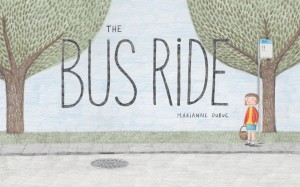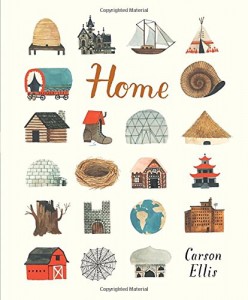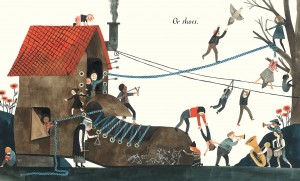March 19, 2015
The Bus Ride by Marianne Dubuc
 We’re becoming big fans of Marianne Dubuc’s books at our house, having enjoyed In Front of My House and Animal Masquerade. You will recall that picking up the latter title resulted in our entire family eventually assembling on the couch, gathering together captured by the book’s magic, and laughing hysterically at the surprises and absurdity. Dubuc’s latest book, The Bus Ride, similarly engages and surprises, and while it’s is very loosely based on the Little Red Riding Hood narrative, a more fitting descriptive for the story would be “curiouser and curiouser.”
We’re becoming big fans of Marianne Dubuc’s books at our house, having enjoyed In Front of My House and Animal Masquerade. You will recall that picking up the latter title resulted in our entire family eventually assembling on the couch, gathering together captured by the book’s magic, and laughing hysterically at the surprises and absurdity. Dubuc’s latest book, The Bus Ride, similarly engages and surprises, and while it’s is very loosely based on the Little Red Riding Hood narrative, a more fitting descriptive for the story would be “curiouser and curiouser.”
The Bus Ride is the story of a little girl’s first ride along on a city bus to visit her grandmother’s house. Her mother sees her off at the bus stop, ensuring she’s got a snack and a sweater in case she gets cold. And from there the rest of the story is of the bus ride, the bus’s interior each two-page spread. Passengers embark at the front doors and alight through the back. The little girl narrates what she sees in a sentence or two, although the real story is happening in Dubuc’s illustrations. A cat is knitting a scarf that grows ever-longer, a mouse is reading a tiny book, a family of rambunctious moles (I think?) climbs on board and end up swinging from the overhead bars (and one chews on a piece of gum he finds on the floor). A family of wolves boards the bus and the little girl makes friends with the wolf-boy who’s about her age—they share her cookies. A sleepy sloth snoozes the ride away. Someone’s hiding behind a newspaper whose headlines are ever-changing and reference what’s going on the pictures. I admired in the stolid bear in his big blue boats.
 They pass through the forest, through a tunnel. Children run amuck. The fox keeps sleeping. The owl woman in the hat seems quite uncomfortable, and characters keep turning up in different places. The turtle gets nervous and hides in his shell. A wannabe pickpocket—a fox, of course—boards the bus, and and the little girl helps to divert a crime. And what is the beaver carrying inside his really big box?
They pass through the forest, through a tunnel. Children run amuck. The fox keeps sleeping. The owl woman in the hat seems quite uncomfortable, and characters keep turning up in different places. The turtle gets nervous and hides in his shell. A wannabe pickpocket—a fox, of course—boards the bus, and and the little girl helps to divert a crime. And what is the beaver carrying inside his really big box?
While The Bus Ride is first a story of one girl’s first independent journey into the world, it’s fundamentally a story of how interesting the world is and how fascinating it is to be in the midst of it all. At the end of the bus ride, the little girl reflects on all the stories she has to tell her grandmother now. Hers is an apprenticeship in narrative, but it is for the reader as well, who assembles her own story based on the curious scenes depicted in Dubuc’s illustrations, which are detailed and accessible, appealingly rendered in pencil crayon. And like all the very best picture books, it’s completely different with every encounter.
March 12, 2015
Sidewalk Flowers by Jon Arno Lawson and Sydney Smith
 It’s from picture books that I’ve learned that the best books have to be read at least 10 times before you really get a handle on them. Case in point: Sidewalk Flowers by JonArno Lawson and Sydney Smith. A wordless picture book (though a wordless book with an author, take note!) can slip past one pretty quickly. The first time I read it, I thought it was okay. A bit weird. The next few times, I still wasn’t sure. It’s the story of a young girl walking through the city with her father, her red-hoodie one of the few spots of colour on the page for much of the book. The other colour comes from the flowers she encounters on her journey, flowers which are actually weeds, which is the kind of distinction only adults make. In their ubiquity, we forget to note how remarkable it is that a dandelion—a living thing—can grow between cracks in the sidewalk. That a wild thing can be so determined to live, and how wildness continually thwarts a city’s attempt to tame.
It’s from picture books that I’ve learned that the best books have to be read at least 10 times before you really get a handle on them. Case in point: Sidewalk Flowers by JonArno Lawson and Sydney Smith. A wordless picture book (though a wordless book with an author, take note!) can slip past one pretty quickly. The first time I read it, I thought it was okay. A bit weird. The next few times, I still wasn’t sure. It’s the story of a young girl walking through the city with her father, her red-hoodie one of the few spots of colour on the page for much of the book. The other colour comes from the flowers she encounters on her journey, flowers which are actually weeds, which is the kind of distinction only adults make. In their ubiquity, we forget to note how remarkable it is that a dandelion—a living thing—can grow between cracks in the sidewalk. That a wild thing can be so determined to live, and how wildness continually thwarts a city’s attempt to tame.
 And the flowers grow, and the child finds them, picks them. She’s the only one who notices these bits of wild colour on the urban scene, but they’re not all she’s noticing. (This novel’s grasp of the child’s eye view makes it an interesting companion to the award-winning The Man With the Violin). As her father talks away on his cell-phone, and the people around her conduct their business, she sees other things, other colours—the orange of citrus fruit for sale at a greengrocers, the warm yellow of a taxi-cab, a woman in a floral dress who is reading a book at a bus stop. She’s gathering her wild bouquet, part of which she, calling no attention to herself in the process, offers to a dead bird she walks by on the sidewalk, then to a man who is a asleep on a park bench, and to a neighbour’s dog. And as she leaves her flowers, something remarkable is happening to the world all around her—bit by bit, the city becomes rich with colour. Leaves appear on the trees and the sky turns blue. Through the girl’s small acts, the world is transformed.
And the flowers grow, and the child finds them, picks them. She’s the only one who notices these bits of wild colour on the urban scene, but they’re not all she’s noticing. (This novel’s grasp of the child’s eye view makes it an interesting companion to the award-winning The Man With the Violin). As her father talks away on his cell-phone, and the people around her conduct their business, she sees other things, other colours—the orange of citrus fruit for sale at a greengrocers, the warm yellow of a taxi-cab, a woman in a floral dress who is reading a book at a bus stop. She’s gathering her wild bouquet, part of which she, calling no attention to herself in the process, offers to a dead bird she walks by on the sidewalk, then to a man who is a asleep on a park bench, and to a neighbour’s dog. And as she leaves her flowers, something remarkable is happening to the world all around her—bit by bit, the city becomes rich with colour. Leaves appear on the trees and the sky turns blue. Through the girl’s small acts, the world is transformed.
It all happens so subtly, it takes until around the 10th read that it begins to be clear. And even then, the reader is still uncovering new details in Smith’s illustrations—the lion in Chinatown, a cat in the window, the streetcar coming around the corner (which is red!). The images are made interesting and complicated by shadows and reflections, adding extra texture to the story. Smith is depicting an any-city, though the savvy among us will see Toronto with its distinctive architecture and peculiar topography suggested by houses situated up flights up steps on steep hills.
Sidewalk Flowers is a book with mystery at its core, a book that is a manifestation of its theme of generosity, for it has given me something new every time I have encountered it. A wordless book too is an important tool for literacy, for it allows parent and child to remember the reason we open books at all. For them to approach a story for once on the very same level—a whole world to be explored together.
February 27, 2015
Home by Carson Ellis
 While Carson Ellis’ Home is a beautiful book, it first appealed to me conceptually for its similarity to one of my favourite picture books, A House is a House for Me by Mary-Ann Hoberman and Betty Fraser, published in 1978. Both books—with whimsy, strange and gorgeous illustrations (plus a Duchess)—explore the variousness of dwellings, and the curiousness too; from the Hoberman book, “A box is a house for a teabag. A teapot’s a house for some tea. If you pour me a cup and I drink it all up, Then the teahouse will turn into me.” All this to the point where I opened by Ellis’ book, and wondered where were the rhyming couplets.
While Carson Ellis’ Home is a beautiful book, it first appealed to me conceptually for its similarity to one of my favourite picture books, A House is a House for Me by Mary-Ann Hoberman and Betty Fraser, published in 1978. Both books—with whimsy, strange and gorgeous illustrations (plus a Duchess)—explore the variousness of dwellings, and the curiousness too; from the Hoberman book, “A box is a house for a teabag. A teapot’s a house for some tea. If you pour me a cup and I drink it all up, Then the teahouse will turn into me.” All this to the point where I opened by Ellis’ book, and wondered where were the rhyming couplets.
But Ellis’ project with Home is something that’s different, more art-focused than text-focused, and the text itself seeking to open up the book rather than nailing it down, asking questions like, “But whose home is this?” of a home on the edge of a cliff, “And what about this?” of a tiny home underneath a mushroom—a vaguely Alice-ish reference (which gives this book another point in common with Hoberman’s, in addition to a thing for teacups).
 So I sat down with my children and we started to look at the book, delighting in the illustrations (which will appeal to anyone who likes Jon Klassen’s work, which is everyone), and the oddities. Sure, homes are boats and wigwams, but what IS going on in that underground lair, and how strange to have “French homes” on a page with the inhabitants of Atlantis (whose homes are, naturally, underwater).
So I sat down with my children and we started to look at the book, delighting in the illustrations (which will appeal to anyone who likes Jon Klassen’s work, which is everyone), and the oddities. Sure, homes are boats and wigwams, but what IS going on in that underground lair, and how strange to have “French homes” on a page with the inhabitants of Atlantis (whose homes are, naturally, underwater).
Homes on the moon, in a geodesic dome in space, the home of a Norse god, a castle in a fish bowl (with the knights riding sea-horses), “A babushka lives here,” “A raccoon lives here.” The strange juxtaposition of the bizarre and familiar—it’s a weird and wonderful book that invites even more questions than those the text poses.
 But then we started noticing other things—there is a pigeon on every page, and the same teacup recurs every little while, and there’s a monkey on the ship, and on the shoe-home page, there is a little boy on the roof who’s pulled down his pants, and he’s showing us him bum, and the children were howling. We still couldn’t find the pigeon on the “Bee homes” (though it dawns on me that it’s a wasp’s nest, but I digress) page, so we called in back-up and read the whole book for perhaps the fifth time, in the presence of Daddy. The book was so wholly engaging for the entire family, and we all of us loved it at once.
But then we started noticing other things—there is a pigeon on every page, and the same teacup recurs every little while, and there’s a monkey on the ship, and on the shoe-home page, there is a little boy on the roof who’s pulled down his pants, and he’s showing us him bum, and the children were howling. We still couldn’t find the pigeon on the “Bee homes” (though it dawns on me that it’s a wasp’s nest, but I digress) page, so we called in back-up and read the whole book for perhaps the fifth time, in the presence of Daddy. The book was so wholly engaging for the entire family, and we all of us loved it at once.
“An artist lives here.” is the book’s second-to-final image, showing a person at work in her studio, a room filled with fascinating and ordinary objects all of which (or nearly all of which?) are found within the other pages in the book—a shoe on the floor (sans bum), the fish bowl, stripy socks. And also sketches of the actual illustrations tacked up to the wall, giving the story a new puzzle along with a metafictional subtext, as well as underlining the message that creative inspiration—even for imaginative journeys to the farthest reaches of the universe—can be found in the ordinary world all around us. Which is certainly a testament to the nature of home, indeed.





